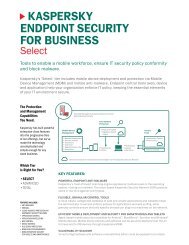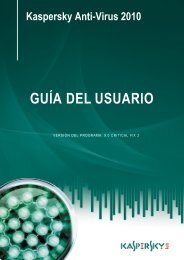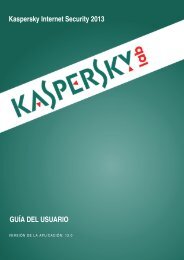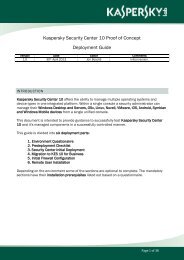Kaspersky PURE User Guide - Kaspersky Lab
Kaspersky PURE User Guide - Kaspersky Lab
Kaspersky PURE User Guide - Kaspersky Lab
Create successful ePaper yourself
Turn your PDF publications into a flip-book with our unique Google optimized e-Paper software.
A D V A N C E D A P P L I C A T I O N S E T T I N G SA D V A N C E D F I R E W A L L S E T T I N G SYou can specify the advanced settings for the Firewall, such as permission of FTP's active mode, connection blockage ifno prompt for action is available (application interface is not loaded), and functioning until the system shutdown.By default, all the settings are enabled.To modify advanced settings of the Firewall, perform the following steps:1. Open the main application window and click the Settings link in the top part of the window.2. In the left part of the window, in the Protection Center section, select the Firewall component.3. Click the Settings button for the component you have selected.4. In the window that opens, on the Filtering rules tab, click the Additional button.5. In the Additional window that opens, check / uncheck the boxes next to the required settings.NETWORK ATTACK BLOCKERNetwork Attack Blocker scans inbound traffic for activity typical of network attacks. Once an attempt of attacking yourcomputer is detected, <strong>Kaspersky</strong> <strong>PURE</strong> blocks any network activity of the attacking computer towards your computer.By default, the blocking persists for one hour. You can edit the blockage settings (see page 145). A notification willappear on the screen that a network attack has been attempted, with specific information about the computer thatattacked you. Descriptions of currently known network attacks (see section "Types of detected network attacks" onpage 143) and methods to fight them, are provided in <strong>Kaspersky</strong> <strong>PURE</strong> databases. The list of attacks which the NetworkAttack Blocker can detect is updated when the application's databases are updated (see section "Update" on page 86).IN THIS SECTION:Types of detected network attacks ................................................................................................................................ 143Enabling and disabling Network Attack Blocker ............................................................................................................ 144Editing the blockage settings ......................................................................................................................................... 145T Y P E S O F D E T E C T E D N E T W O R K A T T A C K SNowadays, a great number of network attacks exist. These attacks exploit vulnerabilities of the operating system andother software, system-type or otherwise, installed on your computer.To ensure the security of your computer, you must know what kinds of network attacks you might encounter. Knownnetwork attacks can be divided into three major groups:Port scan – this threat type is not an attack itself but it usually precedes one since it is one of the common waysof obtaining information about a remote computer. The UDP / TCP ports used by the network tools on thecomputer targeted by an intruder are scanned to find out their status (closed or open).Port scans can tell a hacker what types of attacks will work on that system, and what types will not. In addition,the information obtained by the scan (a model of the system) will help the malefactor to know what operatingsystem the remote computer uses. This in turn further restricts the number of potential attacks, and,correspondingly, the time spent perpetrating them. It also aids a hacker in attempting to use vulnerabilitiescharacteristic of the operating system.DoS attacks, or Denial of Service attacks, are attacks that cause an unstable performance of a system or itscrash. Attacks of this type may affect the operability of information resources under attack (for example,blocking of Internet access).143












